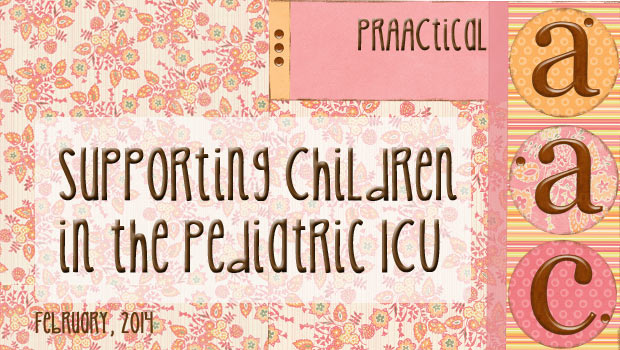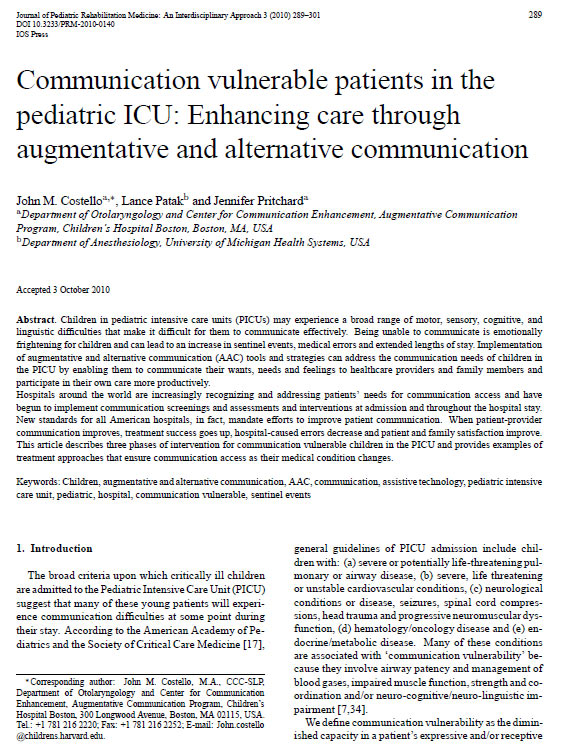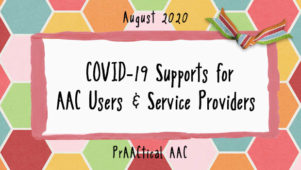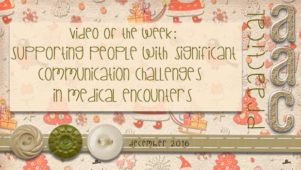Supporting Children in the Pediatric ICU

If there is anything scarier than having a very sick child in the ICU, it has to be when that child has no means of communication. In this  Research Tuesday post, we join the efforts spearheaded by Rachel Wynn of Gray Matter Therapy to share an article that discusses the issues and presents some solution strategies.
Research Tuesday post, we join the efforts spearheaded by Rachel Wynn of Gray Matter Therapy to share an article that discusses the issues and presents some solution strategies.
When we think of research studies in SLP, we think of experimental designs and randomized controlled trials (RCTs). In AAC, group research designs are uncommon because of the immense heterogeneity of this clinical population. Even limiting the study to one single disorder and age group, say teenagers with dysarthria secondary to cerebral palsy, contains too much heterogeneity for most group research. Instead, we see more single subject design experimental studies (SSEDs) in AAC. When well-designed, SSEDs have strong experimental control and allow researchers to answer causal questions, such as “did the treatment (e.g., teaching SGD use) cause the outcome” (e.g., increased number of spoken words).
It is difficult for AAC practitioners, even those with the strongest programmatic support, to design and implement research studies that require experimental control. Today, we look at a case study. While case studies do not allow us to draw a clear line of causality between interventions and outcomes, they still have immense value and should be shared. This is especially true in aspects of the SLP field that are relatively new, and AAC certainly fits into that category. We selected a case study not just because the information is very useful, but also to spark the imagination of our fellow AAC practitioners. You may not be able to marshal the resources to do an experimental study, but descriptive studies are certainly within your grasp. Consider this a call to action: Write what you know and what you do. Then share it with others.
Today, we look at the work being doing at the Boston Children’s Hospital, where the Augmentative Communication Program (ACP) partners with a variety of departments and specialities to support children who have significant speech challenges. In this article, they discuss supports for children who are ‘communication vulnerable,’ a term they use to describe a broad situation in which there is reduction in the patient’s expressive and/or receptive communication skills. They state that in the pediatric intensive care unit (PICU) “such vulnerabilities can relate to the reason for admission (e.g., craniofacial surgery, pulmonary disease, Meningococcemia, etc.) or be secondary to medical interventions, such as intubation, sedation, compounded medications, physical restraints, isolation or a tracheotomy, In addition, some children admitted to the PICU have preexisting congenital disabilities, such as visual, hearing, motor, speech and/or cognitive impairments, that result in a limited understanding of spoken language and/or difficulty producing intelligible speech” (pp 189-190).
The article discusses the ICU experience from a child’s point of view and the sentinel events (unanticipated events that result in serious  physical or psychological harm, or even death) that are a result of poor communication. The authors use this as a starting point for presenting the supports that they use on a regular basis. These supports are presented in the context of the phases in which they are most likely to be used.
physical or psychological harm, or even death) that are a result of poor communication. The authors use this as a starting point for presenting the supports that they use on a regular basis. These supports are presented in the context of the phases in which they are most likely to be used.
- Phase 1: Emerging from sedation: Getting attention and responding to yes/no questions
- Phase 2: Increased wakefulness: Communicating basic information with staff and family
- Phase 3: Need for broad and diverse communication access: Communicating about and beyond the hospital environment
They also discuss the specific issues that arise in the provision of palliative care to children with significant communication difficulties.
You can access the complete article here. Many thanks to the AAC-RERC for making it available free of charge on their website. You can find additional resources on supporting individuals with AAC needs in medical settings here and a video on the topic here.
:::::::::::::::::::::::::::::::::::::::::::::::::::::::::::::::::::::::::::::::::::::::::::::::::::::::::::
Costello, J.M., Patak, L., & Pritchard, J. (2010). Communication vulnerable patients in the pediatric ICU: Enhancing care through augmentative and alternative communication. Journal of Pediatric Rehabilitation Medicine: An Interdisciplinary Approach, 3, 289-301.
Direct link: http://aac-rerc.psu.edu/documents/costello_ped_rehab_2010.pdf
Filed under: PrAACtical Thinking
Tagged With: Boston Children's Hospital, communication vulnerable, healthcare, hospital, John Costello, Medical, Research Tuesday
This post was written by Carole Zangari




